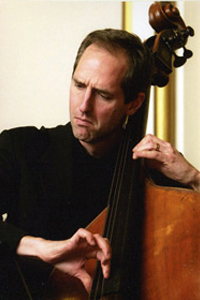Don't see what you're looking for?
Main Site
Berklee.eduCampuses and Schools

Photo provided by the artist
John Funkhouser
For media inquiries, please contact Media Relations
- Bandleader, composer, and pianist/keyboardist for the John Funkhouser Quartet
- Performances/recordings on string bass or piano with Luciana Souza, Tierney Sutton, Joe Lovano, Geri Allen, Francisco Mela, Charles Neville, Max Weinberg, Steve Gadd, Ran Blake, the Aardvark Jazz Orchestra, Natraj, and Matt Savage
- Featured string bass soloist with the New England Philharmonic Orchestra and the MIT Wind Ensemble
- Participation as bassist, pianist, and/or producer in over 60 recordings
- Performances at the Birdland, Blue Note New York, Dizzy’s at Jazz at Lincoln Center, the Kennedy Center, and the New Orleans Jazz Festival, Toulon Jazz Festival, and Costa Rica Jazz Festival
- Appearances on Lifetime Television, ABC’s 20/20, NBC’s Today Show, and NPR
- Currently teaches ear training, bass, piano, and ensembles
- B.A., Cornell University
- M.M., New England Conservatory of Music
"As a performer, I'm into in all kinds of music. I play both bass and piano, and I do gigs in a bunch of different styles—jazz, classical, hip-hop, you name it. I try to bring that variety into the classroom as much as I can. Especially in ear training, I incorporate all different kinds of music: Mozart, Bach, Jobim, Coltrane, or Miles Davis. Sometimes I have students improvise a little bit in solfege. Or in Ear Training 3, which is the semester you work on modes, I bring in Irish and Appalachian fiddle music, because a lot of that tends to be modal. I just try to keep it as interesting as I possibly can."
"Ear training is such a fundamental thing. It's a feedback system involving several factors: reading, writing, and listening to and imagining music. As any one of these abilities improves, the others improve as well, so I always try to come at ear training from all those angles. You get these gradual, incremental realizations: 'Oh, now I understand that song I've been listening to all these years!'"
"One of my favorite things about coaching ensembles is the energy students bring. In my Jam Band Ensemble, the students are insanely into it! They spend hours learning this intricate music and jamming outside of class—I can't believe it sometimes. But there's a big payoff at the end, because the music turns into something much bigger than just the notes."
"In private lessons, I always spend the first lesson finding out what students want to do, and I really make an effort to follow up on it. I even try to be flexible if they start to change course in the middle of the semester, because a lot of times people who are 18 or 19 are really excited about one thing for a couple weeks, then hear something else and think 'I want to do that!' I try to go with that. But I also try to help them think long-term and follow through on things. That's where someone in their forties can help someone in their late teens."
